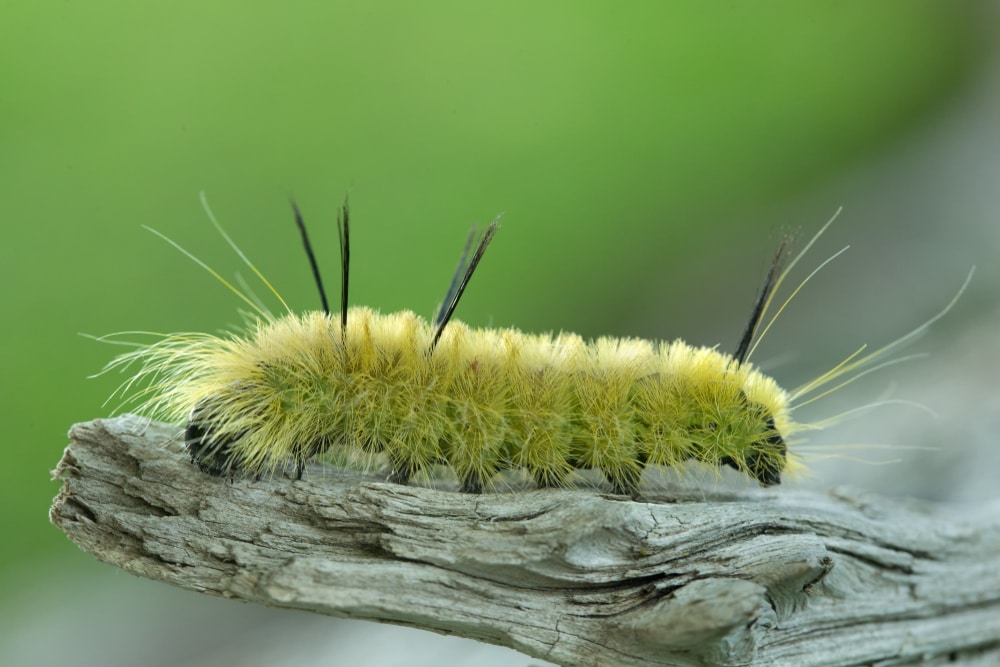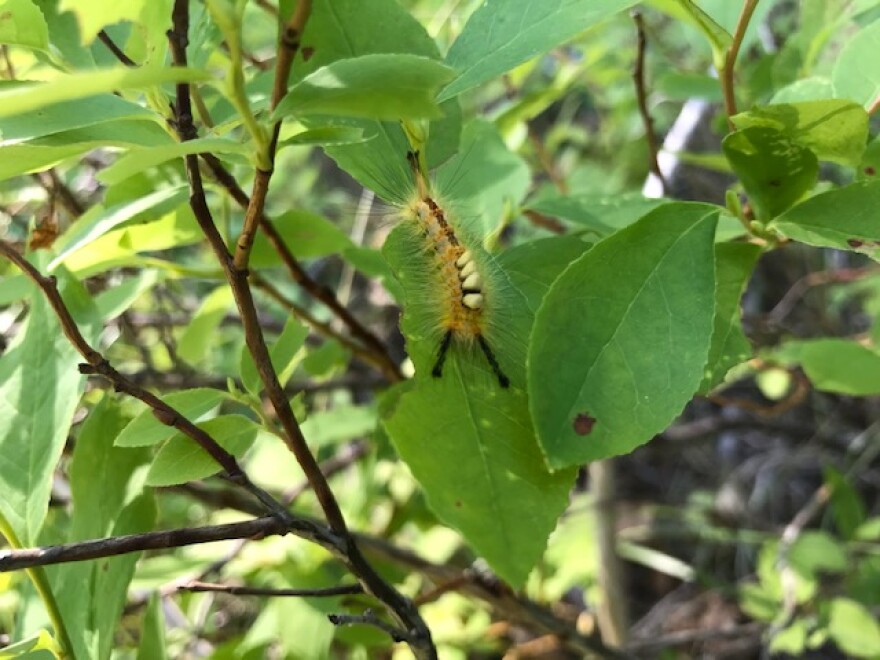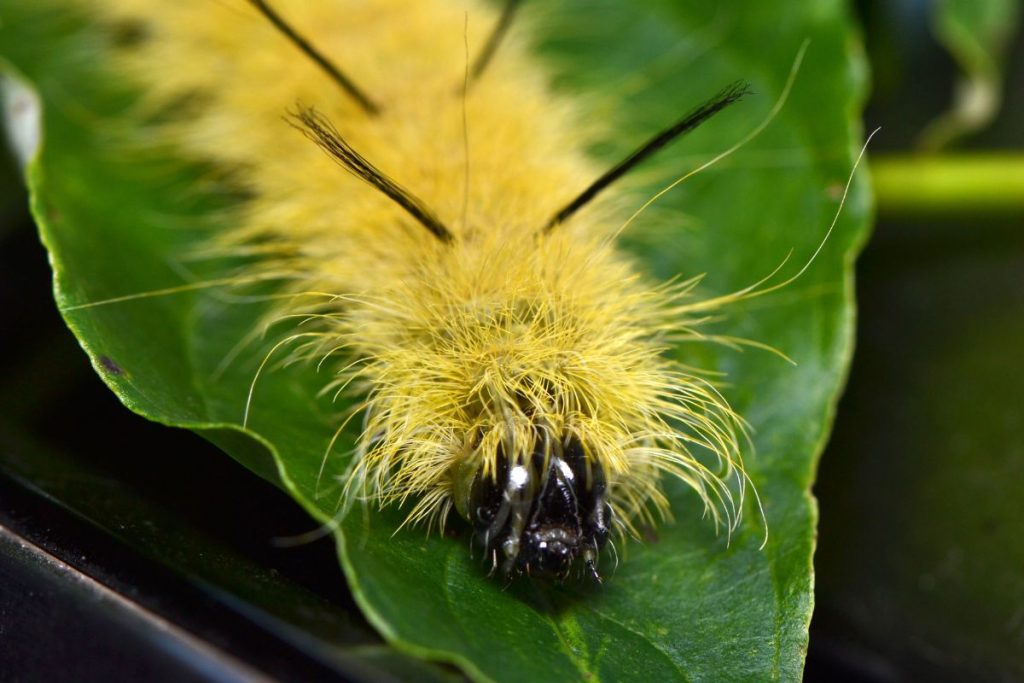American Dagger Moths live in North America. They may seem a bit strange because they’re all fuzzy and have colorful patterns. Some people find them pretty, while others worry about them, particularly when encountering a yellow caterpillar.
Are these moths good or bad? Well, that’s what we’re going to figure out.
These moths have caterpillars that can make you itchy if you touch them. That doesn’t sound great, does it?
But these caterpillars are important because they eat plants, which keeps the balance in the natural world. So, don’t be too quick to judge them.
It’s important to understand these living creatures and their role in our natural habitat.
Identification of American Dagger Moth Caterpillar

You can easily spot the American Dagger Moth Caterpillar; it’s a small caterpillar, about 2 inches long. It’s furry and has black and yellow stripes on its body. These stripes make it look different from other caterpillars.
So, if you see a small, fuzzy caterpillar with black and yellow lines on an oak or maple tree, it’s probably the American Dagger Moth Caterpillar. These little creatures can be interesting to watch as they move around and eat leaves. They are a part of nature’s beauty, and you can enjoy observing them in your garden or nearby parks.
Additionally, if you’re interested in creating a caterpillar-friendly environment, you might want to consider adding some Gardening Tools to your collection.
Some of The Colors the Dagger Moth Can Turn Into
Tiny American Dagger Moth Caterpillars begin with black and yellow lines. As they grow, their colors can switch. They might turn more green or a tad pink. This helps them hide from animals that want to eat them. If you spot one that looks different, don’t be surprised. These caterpillars are really awesome at changing how they look to stay safe.
Remember that nature is full of surprises, and these little caterpillars are a perfect example. So, when you’re outside, be sure to keep your eyes open. You might encounter one of these colorful critters during your next outdoor walk. Nature is fascinating, and a Bug Catcher Kit can be a great tool to have on hand during your outdoor research. It includes essentials like a magnifying glass, tweezers, and a container for safely observing insects.
What Does Dagger Moth Eat?
Dagger Moth Caterpillars are not very choosy eaters. They mainly eat tree leaves, such as oak, birch, and maple. They chew on these leaves, getting the stuff they need to grow. You might see them biting leaf edges, making them look uneven.
These small caterpillars really like to eat a lot. They eat a whole bunch to get bigger and turn into beautiful moths. So, when you see them snacking on leaves, remember they’re just trying to fill their tummies and become splendid moths one day.
These caterpillars don’t mind what kind of tree they eat from. They’re not fussy at all. They’re like little leaf-munching machines, making leaves disappear as they eat more and more.
Keep an eye out for them while they enjoy their leafy meals. If you’re interested in observing them up close, consider using an Insect Observation Container.
Habits and Behaviors

The American Dagger Moths are little insects found on plants and trees. They have soft, small, and prickly hairs that can make your skin feel itchy if you hold them, so it’s better not to touch them. These caterpillars change into grown-up moths. They eat leaves from different trees, but they don’t harm humans by biting or stinging. Instead, they are food for birds and other animals, which is helpful in the big circle of nature.
So, when you see these caterpillars in your garden, remember that they are not dangerous and are a part of nature’s plan. It’s always an excellent idea to observe them from a safe distance and let them go about their business.
Is an American Dagger Moth Poisonous?
No, American Dagger Moths are not poisonous. Their caterpillars have small, spiky hairs, but these hairs are not dangerous. If you hold them, you might feel itchy, or your skin might get a little irritated, but it won’t make you very sick.
It’s a good idea to watch these bugs from far away and not touch them so you don’t get itchy or uncomfortable. These moths are interesting creatures to look at, but it’s important to be careful around them to stay safe.
Don’t worry, though, they won’t cause any big problems if you see them in your garden or somewhere else. Just let them be and enjoy their company from a distance.
Is This Caterpillar Harmful?
The American Dagger Moth’s caterpillar might seem scary because of its spikes, but it can’t hurt people much. It doesn’t have any poison or venom, and its way of protecting itself is by making your skin itch with its tiny hairs. That’s why it’s best not to touch them to avoid feeling uncomfortable, but you won’t get seriously hurt.
These caterpillars are quite interesting to observe. They crawl on leaves and munch on them, getting bigger and bigger until they’re ready to change into a cocoon and become a moth. When they grow up, they’re not yellow anymore, and they turn into a different color.
Conclusion
American Dagger Moths are insects, and people have different opinions about them. Some think they’re nice, while others say they’re not so nice. The interesting thing is they do something helpful for plants.
They munch on leaves, and you might think that’s bad, but it’s actually good because it prevents plants from growing too much. Some birds even consider these moths a tasty snack.
What’s unique about these moths is their tiny, hair-like structures that can sting your skin if you touch them. It might not be good for your skin.
So, whether you like them or not depends on how you look at them and their role in nature.
Be sure to check out these other posts for more fascinating insights:

